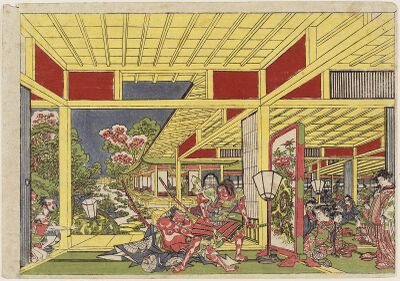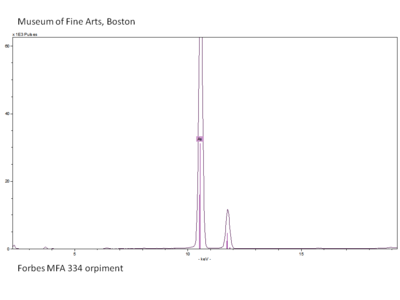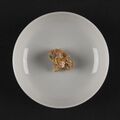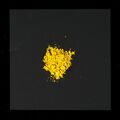Difference between revisions of "Category:Orpiment: Ukiyo-e colorant"
| (23 intermediate revisions by 2 users not shown) | |||
| Line 1: | Line 1: | ||
| − | [[File: | + | [[File:SC214041.jpg|right|400px|link=Toyoharu, The Armor-pulling Scene at Wada's Banquet, 11.14704|The Armor-pulling Scene at Wada's Banquet by Utagawa Toyoharu]] |
| − | <font size="3">'''[[Orpiment]]'''</font> 石黄('' | + | <font size="3">'''[[Orpiment]]'''</font> 石黄 (''sekiō''): An inorganic colorant ground from a soft, yellow mineral composed of [[arsenic%20trisulfide|arsenic trisulfide]]. It produces a brilliant golden yellow color. |
| − | Orpiment and [[:Category:Turmeric: Ukiyo-e colorant|turmeric]] have been the most commonly detected yellows as | + | Orpiment and [[:Category:Turmeric: Ukiyo-e colorant|turmeric]] have been the most commonly detected yellows either as single colorants or as a mixture of the two. Orpiment may have been added to increase opacity and create a vibrant rich golden yellow. An impressive number of greens can be produced when it is mixed in varied proportions with [[:Category:Indigo: Ukiyo-e colorant|indigo]]. From the 1770s through the 1860s, the dominant [[:Category:Indigo/Orpiment: Ukiyo-e colorant|green]] used for printing appears to be a mixture of these two colorants. Orpiment also frequently appears to be overprinted or mixed with [[:Category:Safflower: Ukiyo-e colorant|safflower]] to create [[:Category:Other Reds: Ukiyo-e colorant|orange]]. |
| − | '''For | + | '''For additional information see:''' [[Orpiment]] |
| + | <br> | ||
<br> | <br> | ||
| Line 42: | Line 43: | ||
== Analysis == | == Analysis == | ||
| − | X-ray fluorescence analysis (XRF) is used to detect orpiment (As<sub>2</sub>S<sub>3</sub>). | + | X-ray fluorescence analysis (XRF) is used to detect arsenic (As) and sulfur (S) (depending on instrument settings). When it is found in an area where a yellow colorant was used such as yellow, orange, and green, it is an indication for the presence of orpiment (As<sub>2</sub>S<sub>3</sub>). |
<gallery mode="packed" heights="200px" style="text-align: left"> | <gallery mode="packed" heights="200px" style="text-align: left"> | ||
| − | + | Slide4 FC334.PNG|<center> XRF spectrum of Orpiment</center> | |
</gallery> | </gallery> | ||
| − | == | + | ==Images of Orpiment == |
<gallery> | <gallery> | ||
| + | File:Orpiment mineral.jpg|Orpiment | ||
File:333334 orpiment_2up.jpg|thumb|Orpiment, powdered | File:333334 orpiment_2up.jpg|thumb|Orpiment, powdered | ||
| − | + | File:Orpiment XPL 1000x.jpg|Orpiment, transmitted XPL 1000x | |
| − | |||
| − | File:Orpiment XPL | ||
File:Orpiment PPL 1000x.jpg|Orpiment, transmitted PPL 1000x | File:Orpiment PPL 1000x.jpg|Orpiment, transmitted PPL 1000x | ||
| − | File:Orpiment | + | File:Orpiment (2).jpg|Orpiment |
| + | File:printed orpiment-cropped.jpg|Printed orpiment | ||
| + | File:NMAH-AHB2017q005532.jpg|Orpiment, <small>by National Museum of American History</small>|link=https://americanhistory.si.edu/collections/nmah_1422877 | ||
</gallery> | </gallery> | ||
| − | |||
==List of Prints == | ==List of Prints == | ||
| − | + | Below is a list of prints where orpiment was detected. | |
| − | |||
| − | |||
| − | |||
Latest revision as of 21:27, 12 April 2024
Orpiment 石黄 (sekiō): An inorganic colorant ground from a soft, yellow mineral composed of Arsenic trisulfide. It produces a brilliant golden yellow color.
Orpiment and turmeric have been the most commonly detected yellows either as single colorants or as a mixture of the two. Orpiment may have been added to increase opacity and create a vibrant rich golden yellow. An impressive number of greens can be produced when it is mixed in varied proportions with indigo. From the 1770s through the 1860s, the dominant green used for printing appears to be a mixture of these two colorants. Orpiment also frequently appears to be overprinted or mixed with safflower to create orange.
For additional information see: Orpiment
Examples of Orpiment in Ukiyo-e Prints

|

|

|

|

|
Analysis
X-ray fluorescence analysis (XRF) is used to detect arsenic (As) and sulfur (S) (depending on instrument settings). When it is found in an area where a yellow colorant was used such as yellow, orange, and green, it is an indication for the presence of orpiment (As2S3).
Images of Orpiment
List of Prints
Below is a list of prints where orpiment was detected.
Pages in category "Orpiment: Ukiyo-e colorant"
The following 54 pages are in this category, out of 54 total.
B
E
- Eisen, Fujieda: Kichô of the Owariya, from the series A Tôkaidô Board Game of Courtesans: Fifty-three Pairings in the Yoshiwara, 11.17946
- Eisen, Kawasaki, No. 3 from an untitled series of the Fifty-three Stations of the Tôkaidô Road, 11.25617
- Eisen, Minazuru-hime as Ono no Komachi and Benkei as Kisen Hôshi, from the series Characters from the Life of Ushiwaka as the Six Poetic Immortals, 11.25669
- Eisen, Seijûrô and Onatsu; Banners of Bishamonten; from the series Amusements on the Festival Day, 11.17904
- Eisen, The Song Evening Mist at Asama Peak, on Scrap-paper Fabric with an Itchû-bushi Libretto, from the series A Modern Pine Needle Collection, 11.17878
- Eishi, Shizuka of the Shizutamaya, from the series Beauties of the Yoshiwara as Six Floral Immortals, 21.4917
- Eishi, Shizuka of the Shizutamaya, from the series Beauties of the Yoshiwara as Six Floral Immortals, 53.21
- Eishi, Utamaki of the Takeya, kamuro Futaba and Midori, from the series New Year Fashions as Fresh as Young Leaves, 34.336
H
- Harunobu, Beautiful Women of the Yoshiwara, Combing hair (2006.1537.1)
- Harunobu, Courtesan Watching Two Kamuro Make a Snow Dog, 21.4463
- Harunobu, Nishikigi of the Kanaya Lighting Incense beside a Mosquito Net, 11.16479
- Harunobu, Osen of the Kagiya and a Young Man with a Cat, 11.19496
- Harunobu, Parody of Saigyô Hôshi: Courtesan Looking at a Screen Painting of Mount Fuji, 11.19431
- Harunobu, Young Woman Tuning a Shamisen, 06.479
- Hiroshige I, Naitô Shinjuku, Yotsuya, from the series One Hundred Famous Views of Edo, 11.35823
- Hiroshige I, Pine of Success and Oumayagashi, Asakusa River, from the series One Hundred Famous Views of Edo, 11.17029
- Hiroshige I/Hiroshige II, Ueno Yamashita, from the series One Hundred Famous Views of Edo, 11.35842
- Hokkei, Goat Standing by a Plum Tree, 21.9277
- Hokkei, Ômori, from the series Souvenirs of Enoshima, a Set of Sixteen, 11.19845
K
- Kiyomitsu I, Actor Segawa Kikunojô II as Seryômura Okiku, 11.18992
- Kiyonaga, A Matchmaking Meeting at a Teahouse by a Shrine, 21.5574
- Kiyonaga, Actors Matsumoto Kôshirô IV as Ukita Sakingo and Sawamura Sôjûrô III as the Ghost of Takao, with chanters Tomimoto Itsukidayû and Tomimoto Awatayû, and accompanist Sasaki Ichishirô, 11.13921
- Kiyonaga, Actors Matsumoto Kôshirô IV as Ukita Sakingo and Sawamura Sôjûrô III as the Ghost of Takao, with chanters Tomimoto Itsukidayû and Tomimoto Awatayû, and accompanist Sasaki Ichishirô, 21.5476
- Kiyonaga, The Brine Maidens, from the series Current Manners in Eastern Brocade, 11.13880
- Kiyonaga, The Brine Maidens, from the series Current Manners in Eastern Brocade, 21.5610
- Kiyonaga, Women Visiting Enoshima, 11.21277
- Kokan, Couple Cooling Off on a Garden Bench, 11.19524
- Kunisada, Actor Sawamura Tanosuke II, from the series Actor Rebuses, 11.42324
- Kunisada, Poem by Ariwara no Narihira Ason: (Actor Ichikawa Danjûrô VIII as) Seigen, from the series Comparisons for Thirty-six Selected Poems, 11.42663
- Kunisada, Young Woman Pointing and Giggling, from the series Types of the Floating World Seen through a Physiognomist's Glass, 34.471
- Kuniyoshi, Actor Ichikawa Kodanji IV as the Ghost of Asakura Tôgo, 11.30460
- Kuniyoshi, Hosokute: Horikoshi Dairyô, from the series Sixty-nine Stations of the Kisokaidô Road, 11.28766
- Kuniyoshi, Takeout Sushi Suggesting Ataka, from the series Women in Benkei-checked Fabrics, 11.36360
- Kuniyoshi, Tsumagome: Abe no Yasuna and the Fox Kuzunoha, from the series Sixty-nine Stations of the Kisokaidô Road, 11.41803
S
- Sharaku, Actor Osagawa Tsuneyo II as Ippei's Older Sister Osan, 11.14673
- Sharaku, Actor Osagawa Tsuneyo II as Ippei's Older Sister Osan, 11.14674
- Sharaku, Actor Osagawa Tsuneyo II as Ippei's Older Sister Osan, 21.7244
- Shigemasa, Perspective Picture of the Sleeping Dragon Plum in the Plum Garden at Kameido, 11.14977
- Shinsai, Chapters 22–24, from the series The Tale of Genji, 11.20034
- Shinsai, Chapters 25–27, from the series The Tale of Genji, 21.9264
- Shunkō, Actors Ichikawa Danjûrô V as Fukurokuju, Iwai Hanshirô IV as Ryûyô Dôji, and Sawamura Sôjûrô III as Shin'yô Dôji, 11.14971
- Shunkō, Actors Nakamura Nakazô I and Ôtani Hiroji III, 11.2014
- Shunshō, Actor Segawa Kikunojô III as Shirokiya Okoma, from the series Fans of the East, 11.14871
- Shunshō, No. 6, Cui Zongzhi (Saisôshi), from the series Eight Immortals of The Wine Cup, 11.14847
T
- Taito II, Court Lady and Pine Shoots, 21.9244
- TEST-Utamaro I, Women Overnight Guests, a Triptych, 21.6328-30
- TEST-Utamaro I, Women Overnight Guests, left panel of triptych, 21.6328
- Toyoharu, A Fashionable Picture of Wada's Banquet, from the series Scenes of Japan in Perspective Pictures, 54.1499
- Toyoharu, The Armor-pulling Scene at Wada's Banquet, 11.14704









